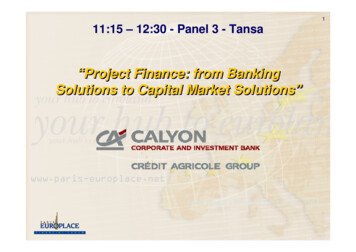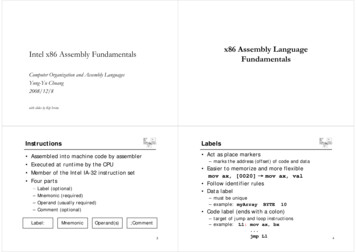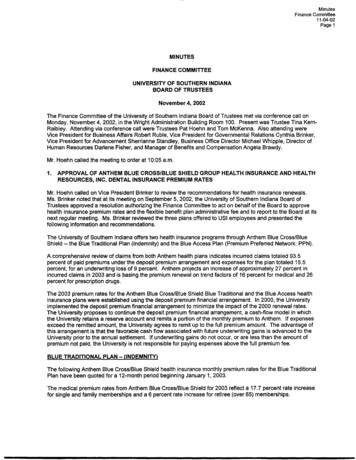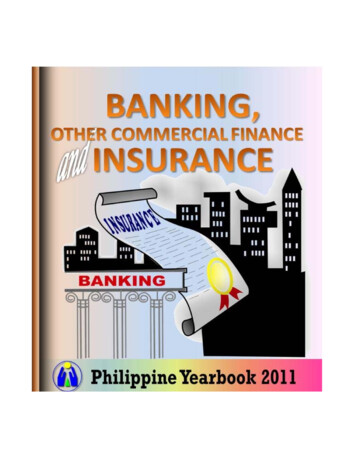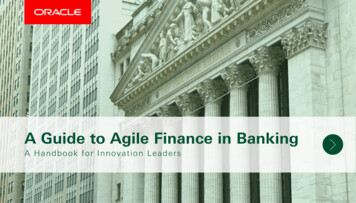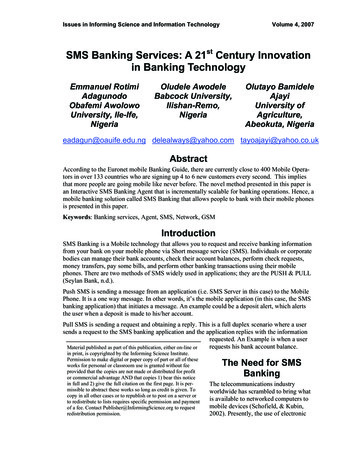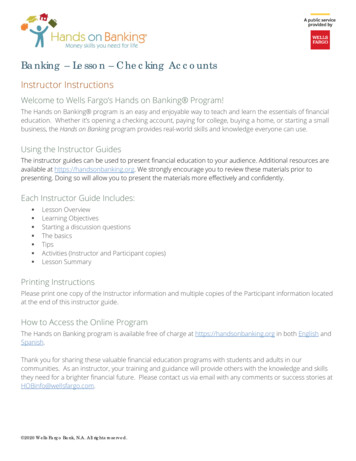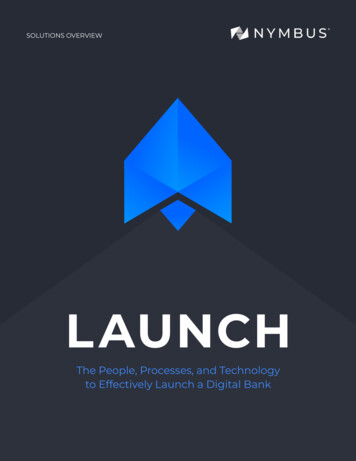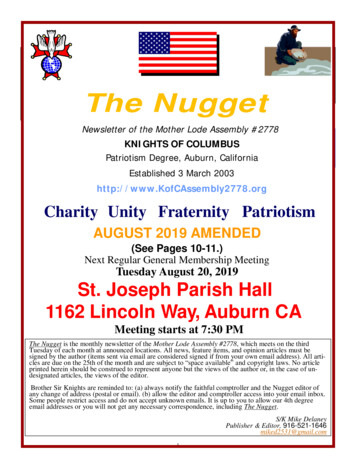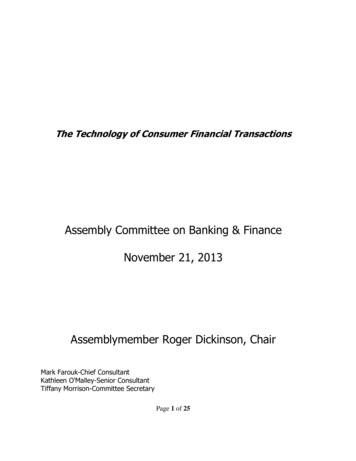
Transcription
The Technology of Consumer Financial TransactionsAssembly Committee on Banking & FinanceNovember 21, 2013Assemblymember Roger Dickinson, ChairMark Farouk-Chief ConsultantKathleen O'Malley-Senior ConsultantTiffany Morrison-Committee SecretaryPage 1 of 25
On March 11th, 2013 the Committee on Banking and Finance conducted a hearing titled,Emerging Technology and the California Money Transmission Act. That hearing focusedon the growing use of alternative means to send and receive payments within theUnited States and around the globe. That hearing led to the introduction of AB 786(Dickinson) which revised and updated various provisions of the Money TransmissionAct (MTA) in order to address changes in technology that required revisions to the MTA.AB 786 was signed by Governor Brown on October 4, 2013. A substantial amount ofconsumer financial transactions are covered under the MTA. While working on AB 786committee staff encountered a broad set of questions and issues concerning the growthof mobile payments and alternative payment networks. This growth has brought aboutnumerous developments in regulatory policy making, as well as, potential legislativeaction. For the most part California and the United States have a financial regulatorysystem geared toward stagnant technology and business models. The existingstructure largely covers insured depository institutions (banks) or non-bank entities thatassist with international remittances. These historical models have focused on ensuringthe safety and soundness of the institutions and preventing money laundering activity.In addition to these layers, existing legal frameworks establish the rights andresponsibilities of each party to a transaction and the appropriate procedures if loss orfraud occurs. The emergence of new technologies has blurred these lines in some waysbecause new middle parties have been introduced into the payments space. Mostdevelopments in mobile applications that send or receive money, or pay for goods andservices are still connected to a traditional payment method, such as credit card orchecking account. In this environment the traditional payment offerings are stillpresent, but the legality of the roles they play are still part of a larger discussion anddebate within the payments industry and among federal and state regulators.Traditional Methods of Payment:Today, electronic payments made through payment card networks and the automatedclearinghouse system (ACH) make up four out of five noncash payments in the UnitedStates according to a 2010 Federal Reserve study on payments. The use of plasticcredit or debit cards has become ubiquitous for the majority of consumer payments.Consumers use their cards to pay for goods or services and within seconds atransaction is approved and the sale is complete. This interaction is so frequent thatrarely would anyone ask about the behind the scenes aspect of this transaction. Whathappens in those few seconds? Who are the parties to the transaction? What legalframeworks govern these transactions?The terminology and process of a credit card transaction:Acquirer- A bank that processes and settles a merchant's credit card transactions withthe help of a card issuer.Page 2 of 25
Authorization- The first step in processing a credit card. After a merchant swipes thecard, the data is submitted to merchant’s bank, called an acquirer, to requestauthorization for the sale. The acquirer then routes the request to the card-issuingbank, where it is authorized or denied, and the merchant is allowed to process the sale.Batching- The second step in processing a credit card. At the end of a day, themerchant reviews all the day’s sales to ensure they were authorized and signed by thecardholder. It then transmits all the sales at once, called a batch, to the acquirer toreceive payment.Cardholder- The owner of a card that is used to make credit card purchases.Card network- Visa, MasterCard or other networks that act as an intermediary betweenan acquirer and an issuer to authorize credit card transactions.Clearing- The third step in processing a credit card. After the acquirer receives thebatch, it sends it through the card network, where each sale is routed to theappropriate issuing bank. The issuing bank then subtracts its interchange fees, whichare shared with the card network, and transfers the remaining amount through thenetwork back to the acquirer.Discount fee- A processing fee paid by merchants to acquirers to cover the cost ofprocessing credit cards.Funding- The fourth and final step in processing a credit card. After receiving paymentfrom the issuer, minus interchange fees, the acquirer subtracts its discount fee andsends the remainder to the merchant. The merchant is now paid for the transaction,and the cardholder is billed.Interchange fee- A charge paid by merchants to a credit card issuer and a card networkas a fee for accepting credit cards. They generally range from 1 to 3 percent of thetransaction value.Issuer- An financial institution, bank, credit union or company that issues or helps issuecards to cardholders.Page 3 of 25
Chip & Pin and Chip & Signature:The U.S. remains the last development country reliant on the magnetic stripe creditcards (mag stripe). The U.S. is currently on pace to be a full decade behind Europe onthe implementation of credit card chip & PIN technology. Until the introduction of Chipand PIN, all face-to-face credit or debit card transactions used a magnetic stripe ormechanical imprint to read and record account data, and a signature for verification.Under this system, the customer hands their card to the clerk at the point of sale, whoeither "swipes" the card through a magnetic reader or makes an imprint from the raisedtext of the card. In the former case, the account details are verified and a slip for thecustomer to sign is printed. In the case of a mechanical imprint, the transaction detailsare filled in and the customer signs the imprinted slip. In either case, the clerk verifiesthat the signature matches that on the back of the card to authenticate the transaction.This system has proved reasonably effective, but has a number of security flaws,including the ability to get physical access to the card via the mail or via the use ofblack market card readers that can read and write the magnetic stripe on the cards,allowing cards to be easily cloned and used without the owner's knowledge.Credit card chip technology was established in 1994 by Europay International SA. Thischip technology is also called EMV, as it was named after its original developers,Europay, MasterCard and Visa .A cardholder's data is more secure on the chip-embedded card than on a mag stripecard. Chip-embedded cards support superior encryption and authentication as opposedto mag stripe card making the data on mag stripe cards easier to obtain via fraudulentmeans. Chip technology counters the static nature of mag stripe cards by implementingtechnology that creates dynamic values for each transaction. EMV cards can be usedPage 4 of 25
both online and in face-to-face transactions, both supporting signature and PINverification with PIN being the dominant method used in Europe.As previously mentioned the U.S. is lagging behind in implementation and acceptanceof EMV technology. The first U.S. credit card utilizing EMB was issued by UnitedNations Federal Credit Union (UNFCU) in October of 2010. The primary reason UNFCUissued the card was that many of its members reside outside the U.S. and were in needof a globally accepted card. Outside of the U.S. mag stripe cards are becoming lessaccepted. Several large card issuers in the U.S. (Wells Fargo, JPM Chase, and U.S.Bancorp) have begun to migrate some of their portfolios over to EMV cards, but thusfar in limited quantities and targeted toward higher income card holders. A factor thatis contributing to the limited role out of EMV in the U.S. is that currently no merchantaccepts EMV chip-embedded cards. Most EMV chip cards issued board and in the U.S.also contain a mag strip thus allowing acceptance at all U.S. merchants that acceptcredit cards.Perhaps both the issuance and acceptance of EMV chip cards (and potentially otherchip-enabled devices such as mobile phones) will increase with a recent announcementby Visa. This announcement specified incentives and deadlines to urge U.S. merchantsto accept both contact and contactless chip-enabled cards. One merchant incentiveincludes the elimination of the requirement for annual card network compliancevalidation if 75 percent of a merchant's transactions originate from chip-enabledterminals effective October 1, 2012. For the largest merchants, savings from an annualcompliance validation would average approximately 225,000 a year. Further, Visa setOctober 1, 2015 as the date when a card-present counterfeit fraud liability shift fromissuers to merchant acquirers will be implemented if fraud occurs in a transaction thatcould have been prevented with a chip-enabled payment terminal. While theannouncement lays a path towards EMV chip card migration, it does not necessarily seta path to chip-and-PIN as Visa will continue to support both signature and PINcardholder verification methods.Money Transmission & Mobile Money.At the most basic level money transmission is the transfer of funds involving threeparties, 1) Sender 2) Money transmitter and 3) Recipient. The transfer of funds may beintrastate, interstate, or international. Typically this service is conducted at a physicallocation where the sender of funds pays a fee to the remittance service and the moneyis then wired to the recipient.Large money transmitters may have a home office, transaction clearing centers, servicecenter (s), regional offices, and branches. They may also contract with agents. Agentsmay include established businesses such as grocery stores, truck stops, check cashers,pharmacists, travel agents and supermarket chains. The money transmission homeoffice pays its agents using a fee schedule that provides predetermined charges formoney transmission.Page 5 of 25
This is how the traditional model of money transmission works. A sender enters anagent location and wishes to send 500 to a recipient in another location. The senderprovides the agent the funds and instructions for delivery to the recipient. The agenttakes the funds and instructions and usually enters the transaction into a computerterminal owned by the money transmitter and that is linked to the money transmitter'sprocessing system. Upon receiving the instructions, the money transmitter will contactits appropriate receiving agent for payout to the recipient. The sender and/or receivingagent will inform the recipient that the transmitted funds are available for pick-up. Theavailability of funds to the recipient may range from minutes to several days dependingupon the location and availability of the receiving agent and money transmitter'sdelivery policy. While computers are the typical means for the transferring of money,telephone lines and fax machines are still widely used.According to World Bank estimates, remittances totaled 414 billion in 2009, of which 316 billion went to developing countries that involved 192 million migrant workers.For some individual recipient countries, remittances can be as high as a third of theirGross Domestic Product (GDP). The top recipients in terms of the share of remittancesin GDP included many smaller economies such as Tajikistan (45%), Moldova (38%),and Honduras (25%).Historically, the money transmission involved face-to-face transaction between theconsumer and transmitter agent that would accept the consumer's money and transmitthose funds to another agent outside of the United States for delivery of those funds tothe consumer's family or friends. These transactions were dominated primarily by afew large transmitters such as Western Union and MoneyGram. Subsequent to theissuance of the draft National Conference of Commissioners on Uniform State Lawsmoney transmission act, states across the country amended their statutes to provideenhanced regulation to foreign and domestic transmission and non-bank issued storedvalue. Forty eight states and the District of Columbia have money transmissionlicensing statutes.Money transmission activity is regulated via the California Money Transmission Act(Financial Code Sections 2000-2172). The United States Department of Treasury underthe Financial Crimes Enforcement Network (FinCEN) requires registration of moneyservices businesses (MSB). According to FinCEN an MSB includes any person doingbusiness, whether or not on a regular basis or as an organized business concern, in oneor more of the following capacities, and that meets a threshold of 1,000 per day ormore transactions: Currency dealer or exchanger. Check casher. Issuer of traveler's checks, money orders or stored value.Page 6 of 25
Seller or redeemer of traveler's checks, money orders or stored value; Money transmitter.FinCEN registration does not apply to a bank or a person regulated or registered withthe Securities and Exchange Commission. Entities registered with FinCEN must makeelectronic filings under the Bank Secrecy Act (BSA). As of July 1, 2012, all such filingsmust be electronic and made through the BSA E-Filing System. Reports that must befiled through this system include, but are not limited to: Currency Transaction Report (FinCEN Form 104)Designation of Exempt Person (FinCEN Form 110)Suspicious Activity Report (Form TD F 90-22.47)Suspicious Activity Report by the Securities and Futures Industries (FinCEN Form101)Suspicious Activity Report by Money Services Business (FinCEN Form 109,formerly 90-22.56)Suspicious Activity Report by Casinos and Card Clubs (FinCEN Form 102)Currency Transaction Report by Casinos (FinCEN Form 103, formerly 8362)Registration of Money Services Business (FinCEN Form 107)Report of Foreign Bank and Financial Accounts (Form TD F 90-22.1)These activities are also subject to Federal Reserve Regulation E. On July 21, 2010, theDodd Frank Wall Street Reform and Consumer Protection Act (Dodd Frank Act) wassigned into law. Section 1073 of the Dodd Frank Act creates new protections for U.Sconsumers sending money abroad. Such transfers or remittances as the Act identifiesthem are now the subject of rulemaking by the Consumer Financial Protection Bureau(CFPB) the agency charged with implementing Section 1073. The CFPB issued a finalrule regulating remittance transfers by amending Regulation E (Reg E) that governselectronic transfer of funds. CFPB issued new rules concerning remittance transfer thattook effect October 28, 2013.The new rules require companies to give certain disclosures on fees and other costsprior to payment for the remittance transfer. The rule also gives consumers 30 minutesto cancel a transfer and companies must investigate if a consumer reports a problemwith a transfer. For more detail on these rules ransfer-rule-amendment-to-regulatione/.Mobile technology has opened up a range of possibilities for mobile payments andmoney transmission services yet other countries are far ahead of the U.S. in usage ofthese new payment applications.Page 7 of 25
Mobile money transfer typically refers to services whereby customers can use theirmobile devices to send and receive money or to transfer money electronically from oneperson to another using a mobile phone. This transfer can be either a domestictransfer or international remittance transaction. The key characteristic of mobile moneytransfer services is the fact that they relate to private transactions only (i.e. transactionsinvolving transfers of money from one person to another). Mobile money transferaddresses person-to-person (P2P) money transfers and is a subset of mobile payments.Mobile money transfers using mobile phones require senders to give the money to aremittance center and pay a fee. The remittance center then transfers the moneyelectronically through the phone service provider to the recipient’s phone. In the case ofinternational remittances, the person receiving the money gets a text message advisingof the transfer. The recipient can go to any licensed outlet, including a retail store orrestaurant, to get the money. The recipient may have to pay a fee to collect the money.In the case of domestic remittances, the transfer is handled automatically on the mobilemoney platform.The mobile remittance industry is burgeoning due to the increased penetration ofmobile phones in remote regions and the mushrooming of various remittance serviceproviders, both national and international, for global money transfers. According to theMigration Development Brief of the World Bank, remittance flows to developingcountries were estimated to have reached USD 372 billion in 2011, and are expected toreach USD 467 billion by 2014, and total worldwide remittance flows are expected toreach 615 billion by 2014. India and China rank highest as recipients of migrantremittances, to the tune of 64 billion and 62 billion respectively. Tajikistan andLesotho receive remittances that are as high as 31 per cent and 29 per cent of GDPrespectively. Various money transfers options (phone to phone, cash to phone, phoneto cash, mobile-wallets etc.) can be made conveniently using mobile devices throughplatforms and applications provided by various banking institutions and money transferoperators worldwide. Various money transfer operators provide services either througha network of agents or partnering with banking institutions depending on theregulations of the central bank and other financial bodies of various nations.In 2007, Safaricom and Vodafone launched a mobile money transfer service called MPESA. Five years later M-PESA provides services to 15 million Kenyans (more than athird of the country’s population) and serves as a conduit for a fifth of the country'sGDP. M-PESA now processes more transactions domestically within Kenya than WesternUnion does globally and provides mobile banking facilities to more than 70% of thecountry’s adult population. However, the service cannot function without the presenceof the formal financial sector. Bank branches are a vital part of the cash managementoperation of an M-PESA agent. Moreover, the early adopters of the service in Kenyawere more likely to be banked than non-users. M-PESA has also been implemented inTanzania, South Africa and Afghanistan. The M-PESA application has also served as aPage 8 of 25
platform for innovations in other areas such as insurance, savings and banking inKenya.In Pakistan, 89% of the adult population does not have a bank account. Easypaisa wasestablished in 2009 in Pakistan through a partnership between Telenor Pakistan andTameer Microfinance Bank. The regulation mandated a bank led model and hence thelicense for branchless banking rests with Tameer Microfinance Bank, while TelenorPakistan also acquired 51% ownership in Tameer for better governance of the newbusiness. The partnership has developed a network of over 20,000 agents. The maindifferentiating factor in Easypaisa is that customers do not require a mobile phone oraccount with Telenor to pay their bills or to send/receive money. These transactions aredone at any of the 20,000 Easypaisa shops around the country by the merchant on hismobile phone. In 2010, Easypaisa mobile accounts (m-wallets) were launched forTelenor SIM subscribers only. Mobile Account subscribers use their own phones for alltransactions and only need to go to Easypaisa shops in Pakistan to deposit or withdrawcash from their Easypaisa mobile account. Services offered include bill payments,money transfers, airtime purchase, savings and insurance, retail purchase, corporatesolutions, viewing account balances and recent transactions, managing PIN codes, andso on. In 2012, Easypaisa conducted on average over 5 million transactions everymonth.GCASH is a mo
of EMV technology. The first U.S. credit card utilizing EMB was issued by United Nations Federal Credit Union (UNFCU) in October of 2010. The primary reason UNFCU issued the card was that many of its members reside outside the U.S. and were in need of a globally accepted card. Outside
